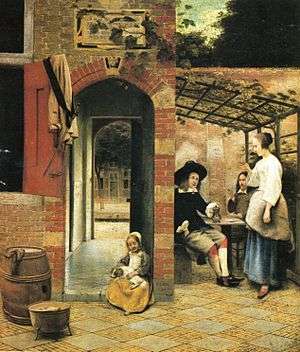The Courtyard of a House in Delft
 | |
| Artist | Pieter de Hooch |
|---|---|
| Year | 1658 |
| Medium | Oil on canvas |
| Dimensions | 73.5 cm × 60 cm (28.9 in × 24 in) |
| Location | Collection of the National Gallery, London, London |
The Courtyard of a House in Delft is a 1658 painting by Pieter de Hooch, an example of Dutch Golden Age painting.

This is a masterpiece of clear and direct depiction of domestic architecture typical of de Hooch's middle period. The building and courtyard seem to take precedence over the strangely detached figures in the painting. The stone tablet above the doorway was originally over the entrance of the Hieronymusdale Cloister in Delft. In English it reads: "This is in Saint Jerome's vale, if you wish to repair to patience and meekness. For we must first descend if we wish to be raised." When the cloister was suppressed this tablet was removed but can still be seen set into the wall of a garden behind the canal. The two adult figures can also be seen in Interior of a Dutch House (1658) and the woman in black and red can be seen in A Boy Bringing Bread (1663). A similar composition with the same doorway can be seen in the Courtyard with an Arbour, also dated 1658, which sold in 1992 for almost seven million dollars.[1]
There are some subtle effects that are at variance with the overall impression of harmony. The brickwork of the wall on the right is in a sad state compared to the house on the left; there is an interesting double perspective that differentiates the two halves that are divided by the right edge of the archway and building above. Nature is making incursions to the well swept courtyard from the plant border on the right, the shrub above the couple's head and the vine obscuring the stone tablet. This painting by Hooch was documented by Hofstede de Groot in 1908, who wrote; "291. VIEW INTO THE COURTYARD OF THE FORMER CLOISTER OF HIERONYMUSDALE, IN DELFT. Sm. Suppl. 50. ; de G. 38.[2] On the left of a courtyard is a porch built of red brick and stone, with an inscription let into the wall above. A woman, with her back to the spectator, stands in full light within the passage. To the right of the porch is a high fence with a vine growing over it ; there is an open door in the wall to the right, from which a few steps lead down into the paved courtyard. A woman carrying a dish in her left hand descends the steps, holding a little girl by her right hand. In the right foreground are a pail and a broom. The portal with the inscription comes from the old Hieronymusdale Cloister, which stood in the Oude Delft, diagonally opposite the Nieuwstraat in Delft. The inscription, so far as it is legible, runs thus:
- . . . e hyronimus dale
- wilt . . . ntie . . . samheijt begheven
- . . . wy eerst dalle
- wijlle wij w . . . den verheven anno 1614.
This inscription is still extant and reads in full thus:
- Dit is in sint hieronimus daelle
- wildt v tot pacientie en lydtsaemheijt begeeven
- vvandt wij muetten eerst daellen
- willen wy worden verheeven 1614.
"The composition, however uninteresting in description, is rendered in the picture magically attractive" (Sm.). [Compare 299.] Signed to the left on the archway "P. D. H. A 1658 " ; canvas, 29 inches by 23 1/2 inches. Mentioned by Waagen in the Peel Collection (i. 403). Engraved by Rajon. Sales:
- De Smeth van Alphen, in Amsterdam, August I, 1810, No. 46 (2075 florins, M. Backer or Yperen).
- Backer's widow sold it in 1825 (for 10,500 florins, or £945) to Emmerson, by whom it was sold to Sir Robert Peel (Sm.).
- Purchased for the nation with the Peel Collection in 1871.
Now in the National Gallery, London, No. 835 in the 1906 catalogue."[3]
The work was the subject of a poem by Derek Mahon.[4]
Notes
- ↑ Sale record for The Courtyard of a House in Delft with a young Woman and two Men drinking and smoking under an Arbour and a Girl with a Dog on her Lap sitting in a Doorway, a street with a canal beyond at Christie's, lot 104, sale 4915, on 11 December 1992 in London
- ↑ Comparative table of catalog entries between John Smith's first Catalogue raisonné of Hooch and Hofstede de Groot's first list of Hooch paintings published in Oud Holland
- ↑ entry 291 for View into the Courtyard of the Former Cloister of Hieronymusdale, in Delft in Hofstede de Groot, 1908
- ↑ Courtyards in Delft, 1981. Gallery Press. Detailed in Brown, Terence. The Literature of Ireland: Culture and Criticism, Cambridge University Press, 2010. ISBN 978-0-521-13652-5